ISSN ONLINE(2278-8875) PRINT (2320-3765)
ISSN ONLINE(2278-8875) PRINT (2320-3765)
J. K. Maherchandani1, Chitranjan Agarwal2 and Mukesh Sahi3
|
| Related article at Pubmed, Scholar Google |
Visit for more related articles at International Journal of Advanced Research in Electrical, Electronics and Instrumentation Engineering
The present paper discuss the economic feasibility of stand-alone hybrid power system consisting of Biomass/ PV/Wind generators for electrical requirements of the remote locations. It emphasizes the use of renewable hybrid power system to obtain a reliable autonomous system with the optimization of the components size and the improvement of the capital cost. The main source of power to the energy system is biomass generator, whereas, photovoltaic panels and wind generators are the supported additional sources. The batteries are used to store extra energy generated that can further be used for the backup. This investigation assessed the potential of using solar, wind and biomass renewable energy in hybrid off-grid system. The optimization is realized through the NREL HOMER package.
Keywords |
| Biomass generator, renewable hybrid power system, economic feasibility, HOMER |
INTRODUCTION |
| Energy plays a crucial factor in technological and economic development of present society. It has always been the key to man’s greatest dream of a better world. Throughout the history of human race, major advances in civilization have been accompanied by increased consumption of energy. There is a positive relation between per capita energy consumption and per capita income. Therefore, adequate supply of energy at a reasonable cost is a key factor in the advancement of a country in almost all sectors. India is a country with numerically dominant rural population, where its village inhabits about 70 percent of its human resources. Hence, the development of country as a whole is intimately related with the rural development [1]. |
| In developing countries like India, it is very difficult as well as uneconomical to transmit power over long distances through transmission lines, to electrify remote and rural areas. The lack of an electrical network in remote areas and prohibitively high connection cost of grid extension and rough topography often leads to exploration of other options. Stand-alone hybrid systems consisting of renewable sources are found promising ways to satisfy the electrification requirements of these areas [2]. The need for energy efficient electric power sources in remote locations is a driving force for research in hybrid energy system [3]. In addition to that, use of renewable help in reducing fossil fuel consumption levels and the consequent effect of carbon dioxide and other green house gases[4]. The hybrid energy systems also provide an effective solution to meet the power demand in case of shortage from the grid supply. |
| In the present study optimization and modelling of a hybrid energy system to meet the electrical requirements of a remote area with industrial development has been done. It emphasizes the renewable hybrid power system to obtain a reliable autonomous system with the optimization of the components size and the improvement of the capital cost. This hybrid energy system consists of Photovoltaic array, wind turbine and biomass plant accompanied with battery and diesel generator for emergency backup considering uncertain availability of these weather dependent sources. As a first step, an operational scheme has been organized for measuring the electrical load profile, renewable sources availability, their condition and specifications like solar irradiation, wind rate. Then, the whole system is simulated in Hybrid Optimization model for Electric Renewable (HOMER) environment. Finally, simulation results are presented for the proposed hybrid energy system and economical, environment aspects for the same have been discussed. |
ELECTRICAL DEMAND AND RECOURSES ANALYSIS |
| A. Energy Demand |
| For the analysis a remote rural area with some small scale industries near to Udaipur (Rajasthan) is selected. The electrical load in this area is mainly due to the household appliances and small industrial applications. The load profile of a day at such location is considered in keeping both household and small-scale industrial energy requirement of the area. The total load is 5826 kWh per day having approximate peak load of 270 kW. Fig. 1 shown is a combination of both household and industrial load profile. The effect of load due to various shifts through-out a day in factory and security light has also been taken in to account. |
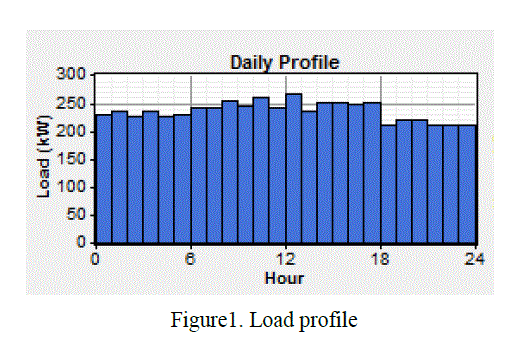 |
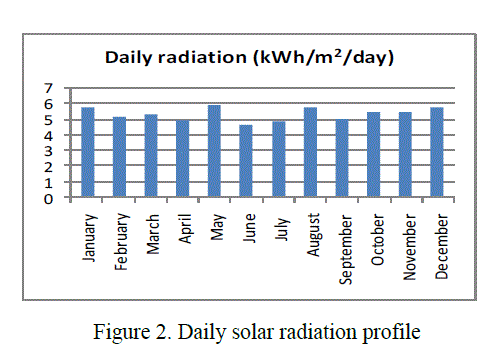 |
| B. Solar Radiation and Wind Speed Data |
| Data estimations about solar, wind and biomass resources with load prediction are necessary for complete system simulation and assessment. In the present work, solar daily radiation data and wind speed data (taken from CTAE college metrological lab, Soil and water conservation department year 2010) represent the averages of the considerable period, for remote village near Udaipur in Rajasthan, India. Geographically it is situated in Aravali range its latitude is 240 40’ N and longitude is 730 36’ E. This data has been analysed to design the hybrid renewable power system to meet the load requirements of a typical remote rural area in Udaipur district. As shown in Fig.2, the average daily solar irradiance for a month ranges from 4.5 to 6 (kWh/m2) and the monthly average wind speeds can be depicted from Fig. 3. |
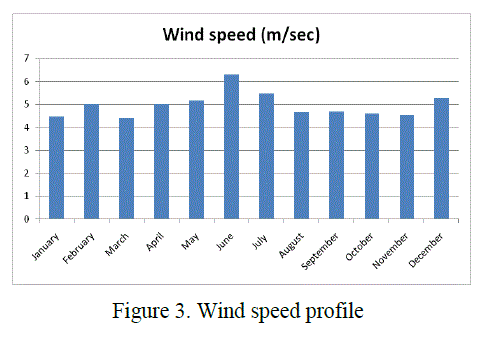 |
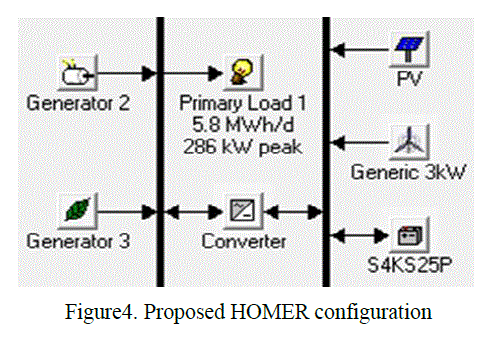 |
HOMER SIMULATION MODEL |
| In the present work, the sizing and selection of components of a hybrid power system has been done by using NREL’s HOMER software. HOMER is general purpose hybrid system design software that facilitates design of an electric power system for stand-alone applications. The input information that are provided to HOMER includes electrical loads, renewable resources, component specifications and costs, constraints, controls, type of dispatch strategy, etc. HOMER designs an optimal power system to meet out the desired loads requirement. HOMER is a simplified optimization model, which performs hundreds or thousands of hourly simulations over and over in order to design the optimum system [5]. The model has been developed using HOMER, consists of a PV, WG(s), a battery and a biomass generator. The schematic diagram of this hybrid power system is shown in Fig. 4. The details of proposed hybrid system components are presented in table I. |
SIMULATION RESULTS |
| The simulation results for hybrid system are presented in table II. The first row shows the optimum hybrid system consisting of PV modules, Wind generator, Biomass generator and Battery to meet the load demand. The cost of energy for purposed hybrid PV/WG/biomass generator has been found to be is 0.037(US$/kWh) as shown in table III. The annual electric energy production and annual electric energy consumption is tabulated in table IV and table V respectively. The production of power by individual renewable source is stated here as the percentage fraction. The annual emission of the hybrid system is tabulated in table VI. |
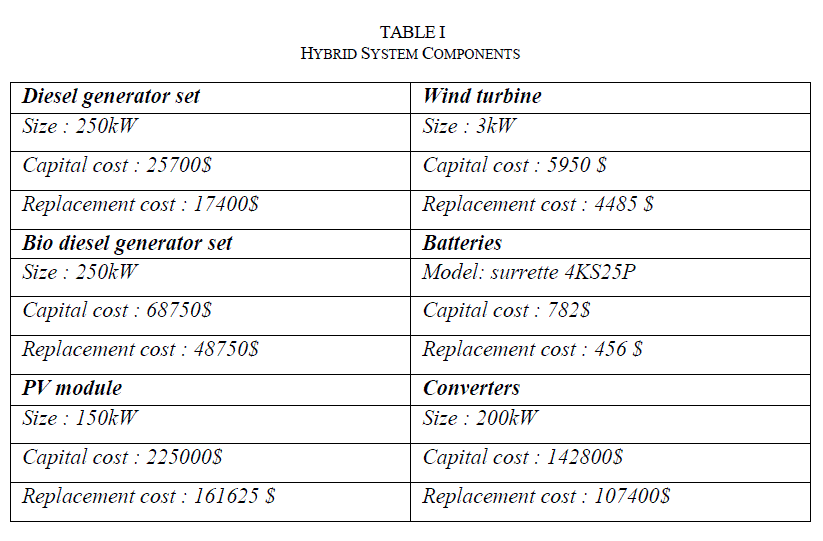 |
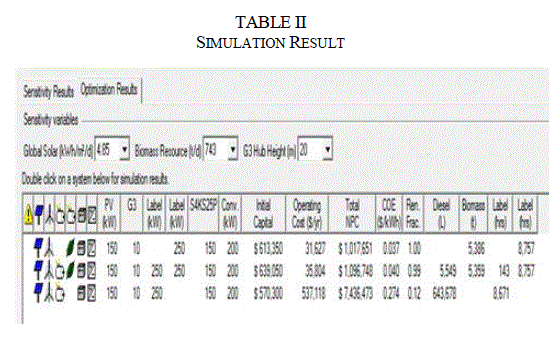 |
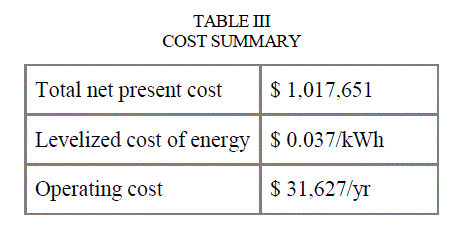 |
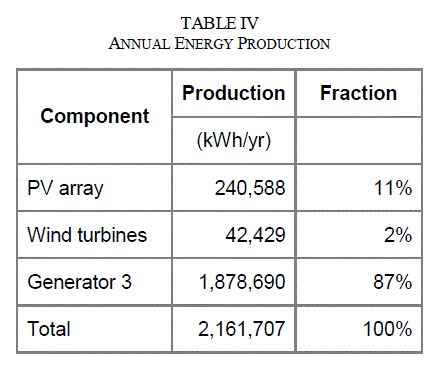 |
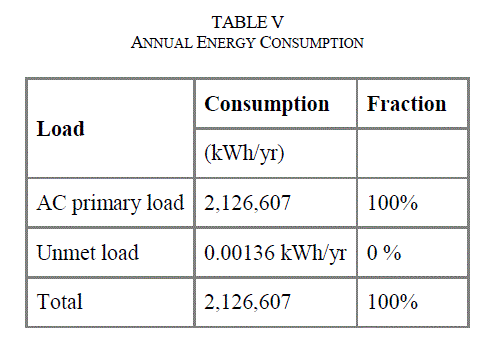 |
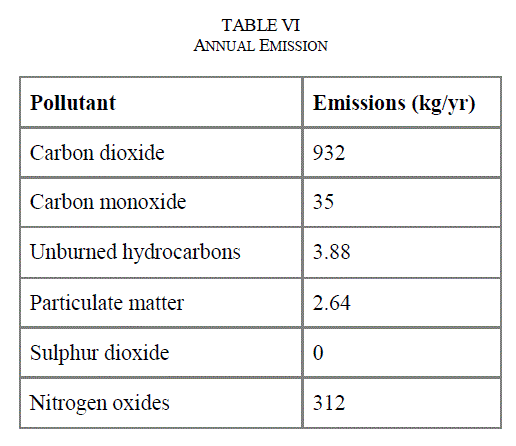 |
CONCLUSION |
| This paper investigates the economic feasibility of the use of a hybrid energy system consisting of biomass/PV/wind for energy requirement of a remote area. Here, biomass generator is chosen as a major source of power in the rural areas due to its high efficiency and cost effectiveness. It is found that the system is managed to supply a total load of approximately 5826 kWh/day. The cost of energy is approximately 0.037 $/kWh or 1.85 Rs/kWh, which is very low as compared to the present domestic tariff rate 4.5 Rs/kWh. Percentage decrease in per unit cost of electricity is 58.8%. Therefore this analysis leads to an optimum cost reduction solution. |
| The preliminary results reported here demonstrate that this stand-alone hybrid power system reduces the operating costs and the emission of greenhouse gases emitted to the atmosphere. |
| Remote places in India have difficulties with connection to the existing grid. Some places do not have that connection at all. As Solar, wind and biomass resources are abundantly present in India. Therefore considering the economic and environmental aspects it is found that this type of hybrid energy system is feasible for rural electrification in the country. |
ACKNOWLEDGMENT |
| The authors acknowledge the support provided by Himmat Singh Chouhan, Mohan Gorana and Narendra Kumar Jangid, of College of Engineering and Technology, Udaipur, Rajasthan, India. |
References |
|